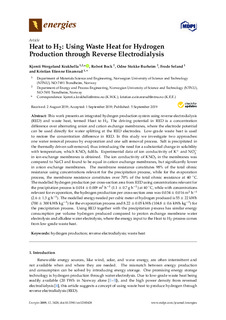| dc.contributor.author | Krakhella, Kjersti Wergeland | |
| dc.contributor.author | Einarsrud, Kristian Etienne | |
| dc.contributor.author | Burheim, Odne Stokke | |
| dc.contributor.author | Seland, Frode | |
| dc.contributor.author | Bock, Robert | |
| dc.date.accessioned | 2019-09-10T07:16:07Z | |
| dc.date.available | 2019-09-10T07:16:07Z | |
| dc.date.created | 2019-09-08T16:14:57Z | |
| dc.date.issued | 2019 | |
| dc.identifier.issn | 1996-1073 | |
| dc.identifier.uri | http://hdl.handle.net/11250/2614380 | |
| dc.description.abstract | This work presents an integrated hydrogen production system using reverse electrodialysis (RED) and waste heat, termed Heat to H2. The driving potential in RED is a concentration difference over alternating anion and cation exchange membranes, where the electrode potential can be used directly for water splitting at the RED electrodes. Low-grade waste heat is used to restore the concentration difference in RED. In this study we investigate two approaches: one water removal process by evaporation and one salt removal process. Salt is precipitated in the thermally driven salt removal, thus introducing the need for a substantial change in solubility with temperature, which KNO3 fulfils. Experimental data of ion conductivity of K+ and NO− 3 in ion-exchange membranes is obtained. The ion conductivity of KNO3 in the membranes was compared to NaCl and found to be equal in cation exchange membranes, but significantly lower in anion exchange membranes. The membrane resistance constitutes 98% of the total ohmic resistance using concentrations relevant for the precipitation process, while for the evaporation process, the membrane resistance constitutes over 70% of the total ohmic resistance at 40 ◦C. The modelled hydrogen production per cross-section area from RED using concentrations relevant for the precipitation process is 0.014 ± 0.009 m3 h −1 (1.1 ± 0.7 g h−1 ) at 40 ◦C, while with concentrations relevant for evaporation, the hydrogen production per cross-section area was 0.034 ± 0.016 m3 h −1 (2.6 ± 1.3 g h−1 ). The modelled energy needed per cubic meter of hydrogen produced is 55 ± 22 kWh (700 ± 300 kWh kg−1 ) for the evaporation process and 8.22 ± 0.05 kWh (104.8 ± 0.6 kWh kg−1 ) for the precipitation process. Using RED together with the precipitation process has similar energy consumption per volume hydrogen produced compared to proton exchange membrane water electrolysis and alkaline water electrolysis, where the energy input to the Heat to H2-process comes from low-grade waste heat. | nb_NO |
| dc.language.iso | eng | nb_NO |
| dc.publisher | MDPI | nb_NO |
| dc.rights | Navngivelse 4.0 Internasjonal | * |
| dc.rights.uri | http://creativecommons.org/licenses/by/4.0/deed.no | * |
| dc.title | Heat to H2: Using Waste Heat for Hydrogen Production through Reverse Electrodialysis | nb_NO |
| dc.type | Journal article | nb_NO |
| dc.type | Peer reviewed | nb_NO |
| dc.description.version | publishedVersion | nb_NO |
| dc.source.volume | 12 | nb_NO |
| dc.source.journal | Energies | nb_NO |
| dc.source.issue | 18 | nb_NO |
| dc.identifier.doi | 10.3390/en12183428 | |
| dc.identifier.cristin | 1722573 | |
| dc.description.localcode | © 2019 by the authors. Licensee MDPI, Basel, Switzerland. This article is an open access article distributed under the terms and conditions of the Creative Commons Attribution (CC BY) license (http://creativecommons.org/licenses/by/4.0/). | nb_NO |
| cristin.unitcode | 194,66,35,0 | |
| cristin.unitcode | 194,64,25,0 | |
| cristin.unitname | Institutt for materialteknologi | |
| cristin.unitname | Institutt for energi- og prosessteknikk | |
| cristin.ispublished | true | |
| cristin.fulltext | original | |
| cristin.qualitycode | 1 | |

